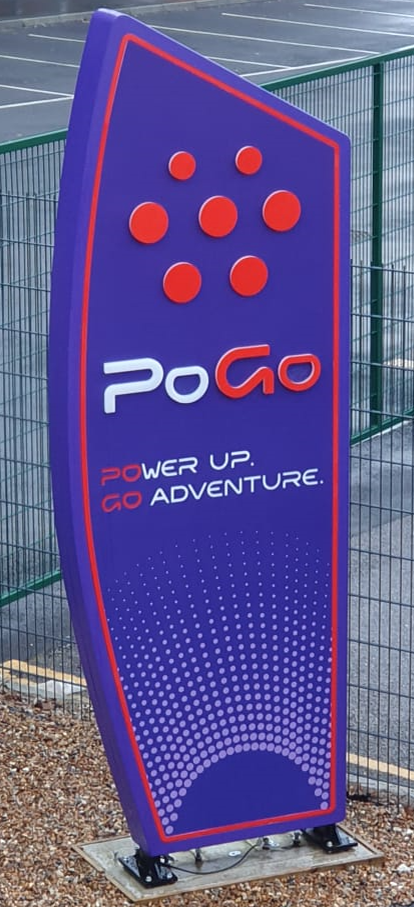Eco-Friendly Sign Manufacturing
Sustainability is now a key focus in the signage industry. More businesses, local councils, and customers are choosing environmentally friendly options when it comes to signs. This shift is not just about following trends – it’s about reducing waste, using recyclable materials, and improving how signs are made to lower their impact on the planet.
Cherwell is here to support that change. With over 40 years of experience supplying the sign trade, we provide reliable access to sustainable signage materials, expert advice, and fast delivery. Our goal is to make it easier for signmakers to choose greener options without compromising on quality or performance.
Why Sustainability Matters in Sign Manufacturing
The way signs are made can have a big impact on the environment. Traditional sign materials often create waste and can be hard to recycle. Over time, this adds up and puts pressure on landfills and natural resources. That’s why sustainability matters — it helps reduce pollution, saves energy, and supports a cleaner future.
In the signage industry, making better choices in materials and production methods can lead to long-term benefits. By rethinking how signs are made, companies can lower their carbon footprint and meet the growing demand for eco-friendly solutions. To understand more about how recycling plays a role in this shift, read our guide on why recycling matters in the signage industry.

Choosing Eco-Friendly Sign Materials
Selecting the right materials is one of the most important steps in eco-friendly sign manufacturing. Many traditional substrates are difficult to recycle or harmful to produce, but there are now better alternatives available. Materials like aluminium composite, steel composite, and responsibly sourced acrylics offer strong performance while being easier to recycle or reuse.
Eco-friendly signage doesn’t mean sacrificing durability or quality. In fact, many sustainable materials are long-lasting and weather-resistant, making them ideal for both indoor and outdoor use. Whether you’re creating shop signage, display systems or directional signs, choosing greener materials helps reduce environmental impact without limiting design possibilities.
To explore some of the most effective sustainable options, see our guide on eco-friendly signage solutions.
Eco-Friendly Sign Manufacturing: Key Considerations
| Aspect | Traditional Signage | Eco-Friendly Signage |
| Materials Used | PVC, acrylic, aluminium composite panels (ACPs) | Recycled acrylic, FSC-certified wood, aluminium, paperboard |
| Production Process | High VOC inks, solvent-based printing | UV/LED printing, water-based or latex inks |
| Energy Consumption | Conventional lighting (fluorescent/halogen) | LED-illuminated signs using less energy |
| End-of-Life Disposal | Often ends up in landfill | Designed for recycling, reuse, or safe decomposition |
| Carbon Footprint | High (from material extraction and energy use) | Reduced through local sourcing, renewable energy, and green logistics |
| Certifications Available | Few/no environmental certifications | Can meet ISO 14001, FSC, or cradle-to-cradle standards |
| Cost | Sometimes lower upfront | Often higher upfront, but lower lifecycle cost |
| Durability | Varies, some materials degrade over time | Eco-materials are improving in durability and weather resistance |
Spotlight on Aluminium and ACM
Aluminium and aluminium composite material (ACM) are two of the most commonly used substrates in the sign industry and for good reason. Both offer strength, lightweight handling, and excellent weather resistance. But when it comes to sustainability, they also have important differences.
Aluminium is fully recyclable and can be reused without losing quality. It’s a great choice for signmakers looking to reduce waste and use materials with a lower environmental impact. ACM, which consists of a plastic core sandwiched between two aluminium sheets, is not as easy to recycle but still offers advantages such as durability and reduced material use.
Understanding when to use aluminium and when to choose ACM can help signmakers make smarter, more sustainable decisions. For a full breakdown, read our comparison of aluminium vs aluminium composite, and explore how the signage industry relies on ACM for its unique benefits.

Understanding Steel Composite Sheets
Steel composite sheets are another popular choice for durable and long-lasting signage. These panels combine a steel surface with a lightweight core, making them strong yet easy to handle. They’re often used in retail signs, totems, and fascia systems where strength and a clean finish are essential.
From a sustainability point of view, steel composites offer several benefits. Steel is widely recycled, and its strength means signs often last longer, reducing the need for replacements. This contributes to less waste over time and helps support more responsible manufacturing.
To learn why so many signmakers choose this material, visit our detailed guide on why signmakers use steel composite sheet.
Cherwell’s Commitment to Sustainable Sign Supplies
We believe sustainability should be simple and accessible for the sign trade. That’s why we stock a wide range of environmentally responsible materials, including recyclable aluminium, composite sheets, and other eco-conscious signage products. Our goal is to support signmakers in reducing waste and choosing smarter materials for every project.
We also offer in-house services like CNC routing and laser cutting, helping you minimise offcuts and make the most of every sheet. With fast, reliable delivery and over 40 years of industry experience, you can trust Cherwell to supply sustainable materials without delays or compromise.
We’re always here to help you explore greener signage options. If you’re ready to make the switch to more eco-friendly solutions, get in touch with our team or browse our range of sustainable sign supplies.
Explore sustainable signage materials and make your projects more environmentally friendly.
Whether you’re looking to reduce waste, meet client sustainability goals, or simply choose smarter materials, we’re here to help.
Contact us to get started.
Frequently Asked Questions
What does eco-friendly sign manufacturing mean?
Eco-friendly sign manufacturing involves using sustainable materials, reducing waste, and adopting processes that minimise environmental impact without compromising quality.
Are aluminium signs recyclable?
Yes, aluminium is 100% recyclable and retains its quality after recycling, making it one of the most sustainable materials used in signage.
Is ACM (Aluminium Composite Material) environmentally friendly?
ACM offers durability and reduced material usage, but it is not as easily recyclable as pure aluminium. However, its long lifespan can help reduce waste over time.
Why should I choose sustainable signage materials?
Using sustainable materials helps reduce your environmental footprint, meet client sustainability goals, and comply with green building standards and local council preferences.
What are the most eco-friendly materials available for signmaking?
Aluminium, steel composite sheets, and responsibly sourced acrylics are among the most sustainable options. These materials offer recyclability, durability, and long service life.


